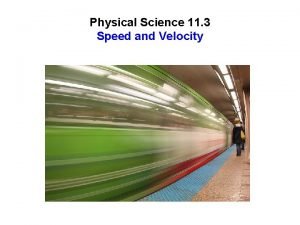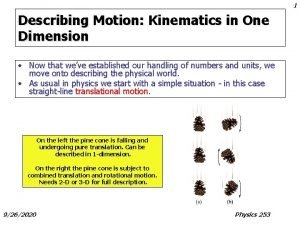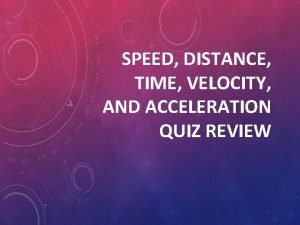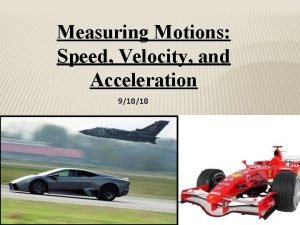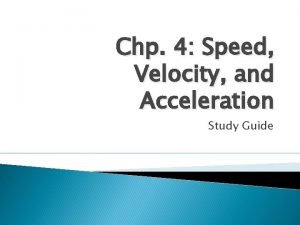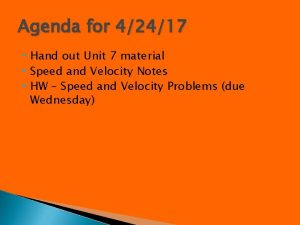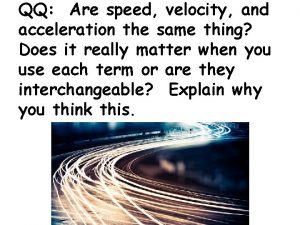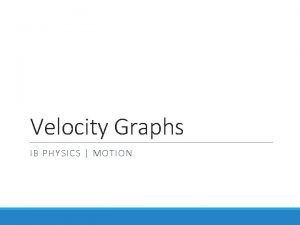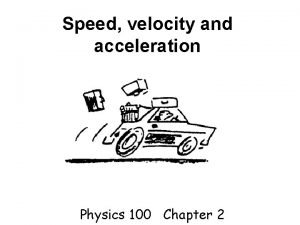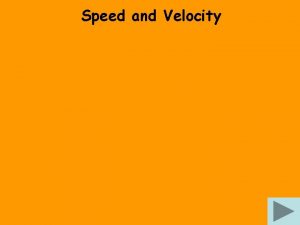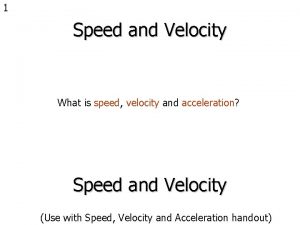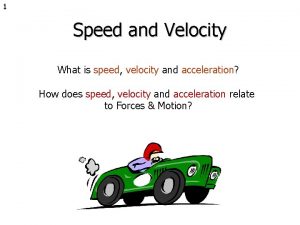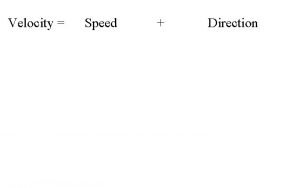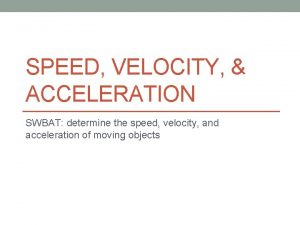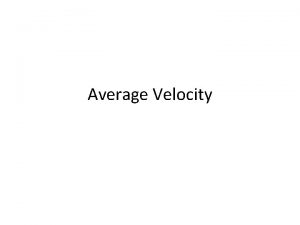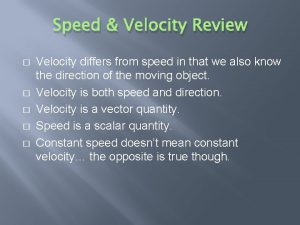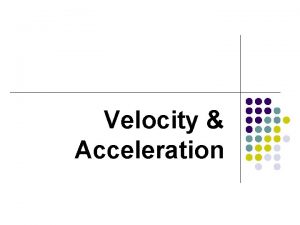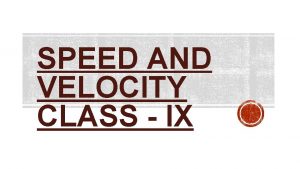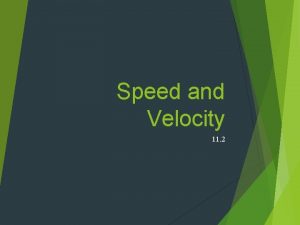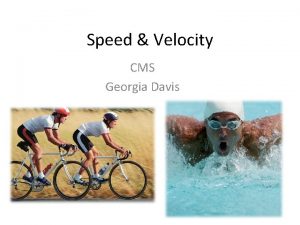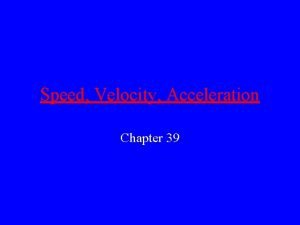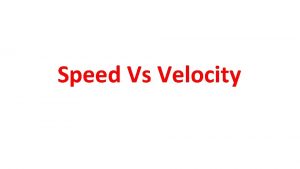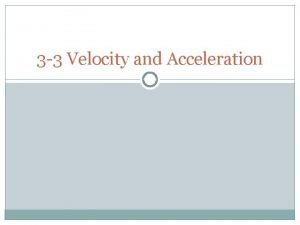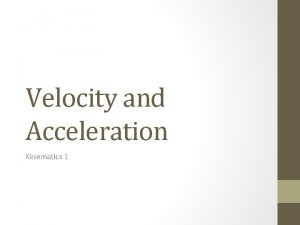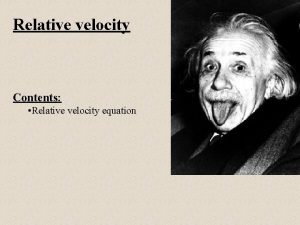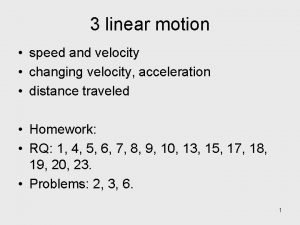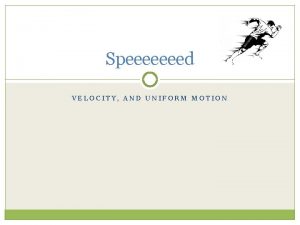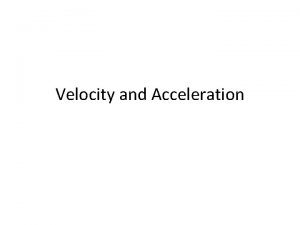Physical Science 11 3 Speed and Velocity Speed

























- Slides: 25

Physical Science 11. 3 Speed and Velocity

Speed and Velocity Speed The ratio of the distance an object moves to the amount of time the object moves Units Measured in m/s or km/hr Average Speed over the entire duration of a trip Instantaneous Speed during a particular instant of time

Average Speed Formula: Speed = Distance (d) Time (t) v= d/t

Solving problems!! • Ask yourself: What is the problem wanting me to solve for? • Find and write the correct formula • Substitute what your know into your formula • Solve equation (Don’t forget units!!)

Average Speed Example #1: You travel 350 meters in 120 seconds. What is your average speed? 2. 92 m/s Example #2: An object travels 100 meters in 4 seconds. What is the objects average speed? 25 m/s

Average Speed Example #3: A train is traveling 10 m/s in 240 seconds. How far did the train travel? 2, 400 meters Example #4: How long did it take an object traveling at 25 m/s to go 2, 000 meters? 80 seconds

How are instantaneous speed and average speed different? • Instantaneous speed is measured at a particular instant in time • Average speed is computed for the entire duration of a trip

Graphing Motion The slope of a line on a distance-time graph is speed § The steeper the slope, the faster you are traveling § The flatter the slope, the slower you are traveling

Graphing Motion Example #1 Each line (A and B) represent the motion of two objects. Which object is moving faster? Explain.

Graphing Motion Example #2 Which car has a faster speed: The big car or small car? Explain

Graphing Motion Example #3 Using this graph, what is the average speed of the Big Car and the average speed of the small

Different Motion Graph Examples

What is the slope of a distance vs. time graph? Speed!!!

Velocity: • A description of both speed and direction of motion. • Velocity is a vector • Velocity has the same formula as speed, except we add a direction

Velocity Example #1 An automobile travels 2, 500 m north along a straight road for 200 seconds. Calculate the velocity. Example #2 A jet liner passes over St. Louis travelling at 625 m/s, heading straight towards Kansas City, which is 235 meters away. How much time elapses before the aircraft passes over Kansas City if it maintains a constant velocity?

Looking at Graphs

Distance vs. Time Graphs • Time always runs horizontally (the x-axis). • The arrow shows the direction of time. The further to the right, the longer time from the start. • Distance runs vertically (the y-axis). • The higher up the graph we go, the further we are from the start.

What is the speed of the airplane? Speed = 1, 200 km / 6 hrs = 200 km/hr Denver Phoenix

Different Slopes Speed = d / t = 0 km/2 hr = 0 km/hr Speed = d / t = 4 km/ 2 hr = 2 km/hr Speed = d / t = 2 km/ 2 hr = 1 km/hr

What is the average speed? • Below a distance vs. time graph of my Average Speed is = Total distance/Total = 12 km/6 hr position during race. What was my = 2 a km/hr AVERAGE speed for the entire race? 12 km 6 hours

Question Below is a distance vs. time graph for 3 runners. Who is the fastest? 7 Distance (mi. ) 6 5 Mr. Lebron James 4 Mr. Usain Bolt 3 Mr. Hess 2 1 0 0 1 2 3 4 5 6 35 Time (h) Mr. HESS is the fastest. He completed the race in 3 hours

Here is another time-distance graph with 2 journeys represented on the same graph. Each line represents a journey from home to the office. The red line is Dave’s journey. The green line is Mike’s journey. How long after Dave does Mike leave? 1500 m 3 seconds D i 1000 After how many seconds s m does Mike catch up? t 7 seconds a How far from home are they n then meet? c 500 m e 500 meters What is the speed of each person? Dave (Red): 70 m/s Mike (Green): 125 m/s 0 5 10 Time (sec) 15

11. 3 Assessment Questions Question #1 How are speed and velocity different? Velocity is speed with direction Question #2 What shows the speed on a distance-time graph? The slope

11. 3 Assessment Questions Question #3 How can two or more velocities be combined? Vector addition

11. 3 Assessment Questions Question #4 What is going on in each section of the following distance-time graph?
 Velocity physical science
Velocity physical science Angular acceleration and linear acceleration
Angular acceleration and linear acceleration Initial velocity and final velocity formula
Initial velocity and final velocity formula Initial velocity and final velocity formula
Initial velocity and final velocity formula Hydraulic conductivity
Hydraulic conductivity Final velocity initial velocity acceleration time
Final velocity initial velocity acceleration time Instantaneous velocity vs average velocity
Instantaneous velocity vs average velocity Derivation of darcy's law
Derivation of darcy's law Tangential speed
Tangential speed Angular acceleration formula in terms of radius
Angular acceleration formula in terms of radius Speed and velocity quiz
Speed and velocity quiz Speed velocity and acceleration problems answers
Speed velocity and acceleration problems answers Motion in straight line formula
Motion in straight line formula Constant speed on distance time graph
Constant speed on distance time graph Speed velocity acceleration
Speed velocity acceleration Velocity describes both speed and
Velocity describes both speed and Velocity acceleration distance formula
Velocity acceleration distance formula Speed velocity and acceleration study guide answers
Speed velocity and acceleration study guide answers Speed challenge lab
Speed challenge lab Are speed velocity and acceleration the same thing
Are speed velocity and acceleration the same thing Graph the particle's velocity and speed where defined
Graph the particle's velocity and speed where defined The main difference between speed and velocity involves
The main difference between speed and velocity involves Speed, velocity and acceleration notes
Speed, velocity and acceleration notes Chapter 1 lesson 2 speed and velocity answer key
Chapter 1 lesson 2 speed and velocity answer key Distinguish between speed and velocity class 9
Distinguish between speed and velocity class 9 Velocity and acceleration
Velocity and acceleration
